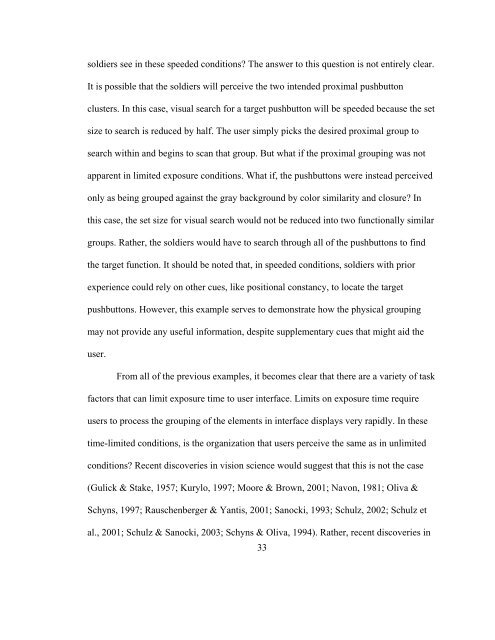The Use of Iambic Pentameter in the
The Use of Iambic Pentameter in the
The Use of Iambic Pentameter in the
You also want an ePaper? Increase the reach of your titles
YUMPU automatically turns print PDFs into web optimized ePapers that Google loves.
soldiers see <strong>in</strong> <strong>the</strong>se speeded conditions? <strong>The</strong> answer to this question is not entirely clear.<br />
It is possible that <strong>the</strong> soldiers will perceive <strong>the</strong> two <strong>in</strong>tended proximal pushbutton<br />
clusters. In this case, visual search for a target pushbutton will be speeded because <strong>the</strong> set<br />
size to search is reduced by half. <strong>The</strong> user simply picks <strong>the</strong> desired proximal group to<br />
search with<strong>in</strong> and beg<strong>in</strong>s to scan that group. But what if <strong>the</strong> proximal group<strong>in</strong>g was not<br />
apparent <strong>in</strong> limited exposure conditions. What if, <strong>the</strong> pushbuttons were <strong>in</strong>stead perceived<br />
only as be<strong>in</strong>g grouped aga<strong>in</strong>st <strong>the</strong> gray background by color similarity and closure? In<br />
this case, <strong>the</strong> set size for visual search would not be reduced <strong>in</strong>to two functionally similar<br />
groups. Ra<strong>the</strong>r, <strong>the</strong> soldiers would have to search through all <strong>of</strong> <strong>the</strong> pushbuttons to f<strong>in</strong>d<br />
<strong>the</strong> target function. It should be noted that, <strong>in</strong> speeded conditions, soldiers with prior<br />
experience could rely on o<strong>the</strong>r cues, like positional constancy, to locate <strong>the</strong> target<br />
pushbuttons. However, this example serves to demonstrate how <strong>the</strong> physical group<strong>in</strong>g<br />
may not provide any useful <strong>in</strong>formation, despite supplementary cues that might aid <strong>the</strong><br />
user.<br />
From all <strong>of</strong> <strong>the</strong> previous examples, it becomes clear that <strong>the</strong>re are a variety <strong>of</strong> task<br />
factors that can limit exposure time to user <strong>in</strong>terface. Limits on exposure time require<br />
users to process <strong>the</strong> group<strong>in</strong>g <strong>of</strong> <strong>the</strong> elements <strong>in</strong> <strong>in</strong>terface displays very rapidly. In <strong>the</strong>se<br />
time-limited conditions, is <strong>the</strong> organization that users perceive <strong>the</strong> same as <strong>in</strong> unlimited<br />
conditions? Recent discoveries <strong>in</strong> vision science would suggest that this is not <strong>the</strong> case<br />
(Gulick & Stake, 1957; Kurylo, 1997; Moore & Brown, 2001; Navon, 1981; Oliva &<br />
Schyns, 1997; Rauschenberger & Yantis, 2001; Sanocki, 1993; Schulz, 2002; Schulz et<br />
al., 2001; Schulz & Sanocki, 2003; Schyns & Oliva, 1994). Ra<strong>the</strong>r, recent discoveries <strong>in</strong><br />
33

















